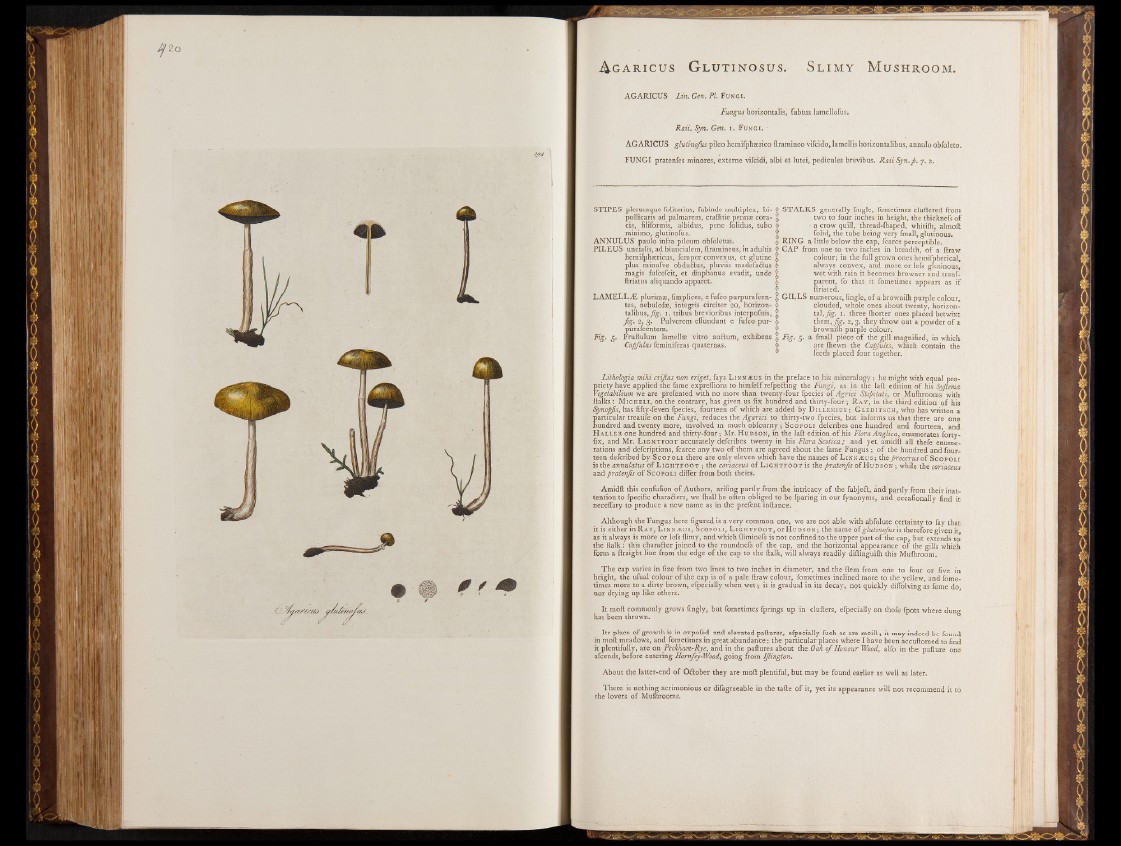
AGARIGUS Lin. Gen. PL Fungi.
Fungus horizontalis, fubtus lamellofus.
Raii. $yn. Gen. 1. Fungi. -
ÀGARICÜS glutinofus pileo hemifphærico ftramineo vifcido, lamellis horizontalibus, annulo obfoleto.
FUNGI pratenfes minores, externe vifcidi, albi et lutei, pédicules brevibus. Raii Syn.p. 7. 2.
STIPES plerumque folitarius, fubinde multiplex, bi- f STALK S generally fingle, fometimes cluftered from
pollicaris ad palmarem, craflitie pennae cora- | two to four inches in height, the thicknefs of
cis, filiformis, albidus, pene folidus, tubo $ a crow quill, thread-fhaped, whitifh, almoft
minimo, glutinofus. ƒ folid, the tube being very fmall, glutinous.
ANNULUS paulo infra pileum obfoletus. $ RING a little below the cap, fcarce perceptible.
PILEUS uncialis, ad biuncialem, ftramineus, inadultis # CAP from one to two inches in breadth, of a ftraw
hemifphaericus, Temper convexus, et glutine * colour; in the full grown ones hemifpherical,
plus minufve obduCtus, pluviis madefaCtus $ always convex, and more or lefs glutinous,
magis fufcefcit, et diaphanus evadit, unde *i‘ wet with rain it becomes browner and tranfftriatus
aliquando apparet. $ parent, fo that it fometimes appears as if
liriated. '
LAMELLAE plurimae, Gmplices, e fufco purpurafcen- | GILLS numerous, fingle, o f a brownifh purple colour,
tes, nebulofae, integris circiter 20, horizon- $ clouded, whole ones about twenty, horizontalibus,
Jig. 1. tribus brevioribus interpofitis, | tal,^g-. m three fhorter ones placed betwixt
Jig. 2, 3. Pulverem effundunt e fufco pur- $ them, fig. 2,3. they throw out a powder of a
purafcentem. brownifh purple colour.
Fig. 5. Fruftulum lamellae vitro auCtum, exhibens | Fig. 5. a fmall piece o f the gill magnified, in which
Capfulas feminiferas quaternas. $ are (hewn the Capfules, which contain the
feeds placed four together.
Lithologia mihi crijlas non eriget, fays L inn æus in the preface to,his mineralogy ; he might with equal propriety
have applied the fame exprefiions to himfelf refpeCting the Fungi, as in the laft edition o f his Syjlema
Vegetabilium we are p'refented with no more than twenty-four fpecies o f Agrià Stipitati, or Mufhrooms with
Italics : Micheli, on the contrary, has given us fix hundred and thirty-four ; R a y , in the third edition o f his
Synopjis, has fiftydeven fpecies, fourteen of which are added by Dillenius; G leditsch, who has written a
particular treadle on the Fungi, reduces the Agarici to thirty-two fpecies, but informs us that there are one
hundred and twenty more, involved in much obfcurity ; Scopoli defcribes one hundred and fourteen, and
H aller one hundred and thirty-four; Mr. Hudson, in the laft edition of his Flora Anglica, enumerates forty-
fix, and Mr. L ightfoot accurately defcribes twenty in his Flora Scotica; and yet amidft all thefe enumerations
and defcriptions, fcarce any two-of them are agreed about the fame Fungus ; o f the hundred and fourteen
defcribed by Scopoli there are only eleven which have the names of L innæus ; the procerus o f Scopoli
is the annulatus of L ightfoot ; the coriaceus o f L ightfoot is the praterifis of Hudson ; while the coriaceus
and pratenjis.oi S copoli differ from both theirs.
Amidfl this confufion o f Authors, arifing partly from the intricacy of the fubjeCt, and partly from their inattention
to fpecific characters, we fhall be often obliged to be fparing in our fynonyms, and occafionally find it
neceffary to produce a new name as in the prefent inftance.
Although the Fungus here figured is a very common one, we are not able with abfolute certainty to fay that
it is either in Ra y , L innæus, Scopoli, L ight foo t, or Hudson; the name oï glutinofus therefore given it,
as it always is more or lefs flimy, and which fliminefs is not confined to the upper part of the cap, but extends to
the ftalk : this character joined to the roundnefs of the cap, and the horizontal appearance o f the gills which
form a ftraight line from the edge of the cap to. the ftalk, will always readily diftinguifh this Mufhroom.
The cap varies in fize from two lines to two inches in diameter, and the flem from orie to four or five in
height, the ufual colour of the cap is of a pale ftraw colour, fometimes inclined more to the yellew, and fometimes
more to a dirty brown, efpecially when wet; it is gradual in its decay, not quickly dilfolvingas fome do
nor drying up like others.
It moft commonly grows fingly, but fometimes fprings up in clufters, efpecially on thofe fpots. where dung
has been thrown.
Its place of growth is in expofed and elevated pafturës, efpecially fuch as are moift ; it may indeed be found
in moft meadows, and fometimes in great abundance ; the particular places where I have been accuftomed to find
it plentifully, are on Peckham-Rye, and in the paftures about the Oak of Honour Wood, alfo in the pafture one
afcends, before entering Hornfey-Wood, going from Iflington.
About the latter-end o f October they are moft plentiful, but may be found earlier as well as later.
There is nothing acrimonious or difagreeable in the tafte of it, yet its appearance will not recommend it to
the lovers of Mufhrooms.